If you have diabetes, being active is crucial for your health and well-being as it helps control blood glucose levels. Exercise is often the first recommended management strategy for individuals with type-2 diabetes. Here are 10 effective exercises specifically tailored for those with diabetes.
Besides managing blood sugar levels, regular exercise also plays a significant role in reducing the risk of heart disease, which is a common concern for people with diabetes. The Nutrition Twins® highlight the importance of exercise in improving glycemic control, promoting better sleep, enhancing mood, and reducing stress levels, which altogether contribute to better overall health for individuals with diabetes.
Now, lace up your sneakers, and let’s explore 10 of the best exercises to do if you have diabetes.
Walking


Establishing a daily walking habit may sound simple, but it works wonders for your mind, body, and soul, no matter your fitness level.
Starting with simple activities like walking post-meals can lead to significant improvements in blood sugar levels. Even a short 10 to 15-minute walk can have a positive impact. Walking is an accessible and easy exercise option that does not require any special equipment, making it a convenient choice for beginners to monitor the immediate effects on blood sugar levels.
Swimming


Swimming is a low-impact, joint-friendly workout that engages your entire body. And you don’t have to swim laps in order for your water regimen to be effective; The Nutrition Twins say taking a water aerobics class or even jogging in the water can be beneficial.
“Your working muscles pull sugar out of the bloodstream and to the working muscles, so when your arms, legs, core, back, and entire body are working when you’re swimming, it’s a very efficient exercise for lowering blood sugar,” they tell us.
Strength Training


Strength training speeds up the fat and calorie burn, even when you’re at rest since it helps sculpt lean muscle. Research shows that resistance training can be an incredibly effective way to lose weight by increasing your metabolic rate.
“Strength training helps you to become more insulin sensitive and improve blood sugar control,” The Nutrition Twins add. “You don’t have to belong to a gym to strength train—you can do pushups (or modified pushups on your knees), lunges, squats, body weight calf raises, and more.”
Squats
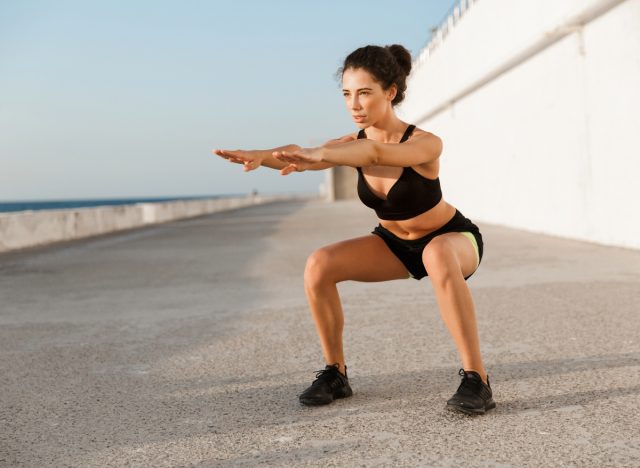

Squat your way to a lean, all-around healthier body!
“Squats are fantastic for blood sugar control as they activate the large muscle groups in the legs which act as a sink for carbohydrates,” The Nutrition Twins say. “The more muscle you have on your legs, the more sugar they will ‘vacuum’ out of the blood and into the muscle to keep your blood glucose levels in check. Squats have [also been shown] to use a lot of sugar for the activity itself, helping lower blood glucose.”
Breaking Sitting for Squats
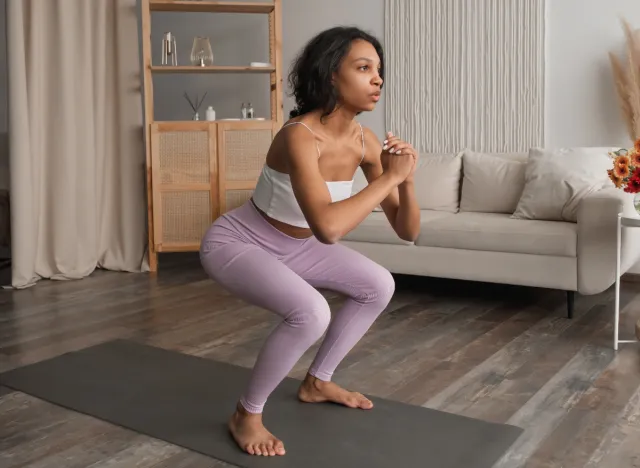

If you work a desk job, you may not take many breaks to move your body during the day. However, The Nutrition Twins stress the importance of carving out some time to get up from a seated position and do some squats or movement snacks.
“The beauty of this is that even if you don’t have time to take a walk or for more structured exercise, research shows that taking a break from sitting—and by simply interrupting prolonged sitting—with short bouts of exercise like squats, can lead to substantial benefits in blood sugar control,” they explain. “Squatting interruptions [were shown] to have a more profound effect than walking interruptions.”
Pilates
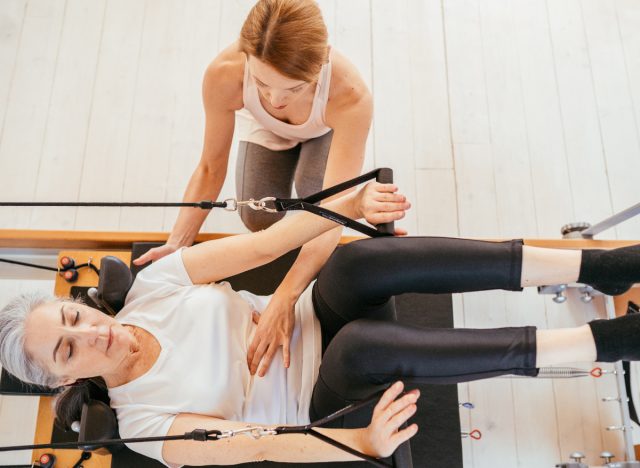

Pilates is a joint-friendly exercise that’s a stellar choice for those who may feel intimidated by workouts that call for more stamina.
“Pilates requires breath control and uses about 50 small, simple, repetitive motions that work the muscles and help to strengthen the core,” The Nutrition Twins explain. Since Pilates uses many different muscles, it’s great for shuttling the sugar out of the blood and into all of the working muscles, helping to lower blood sugar. Research has found that Pilates can help improve glycemic control.”
Walking Lunges


Although walking lunges may be a more challenging exercise for some, start small. Begin with two to three walking lunges, then take a breather and try another few as you work your way up to more.
“By utilizing the biggest muscle group in the body, your leg muscles will take carbohydrates and sugar right out of the blood and to the working muscle, lowering blood sugar levels,” The Nutrition Twins say. “This effective all-over leg and glute exercise will help you to build strength and lean muscle tissue quickly, speeding metabolic rate and ultimately making it easier to lose weight and keep blood sugar levels low.”
High-Intensity Interval Training (HIIT)
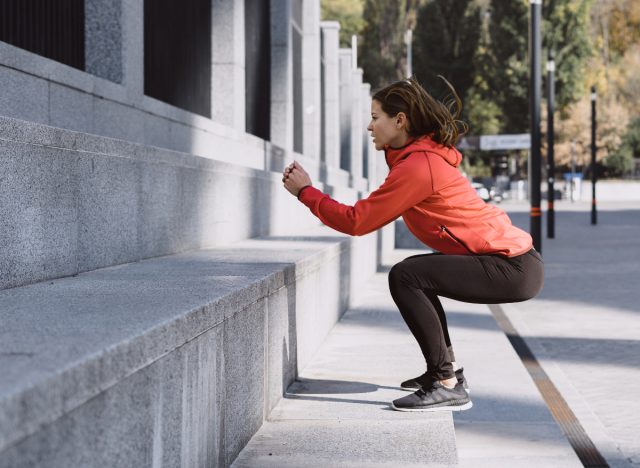

HIIT involves switching between periods of high-intensity and low-intensity exercise. You can utilize HIIT in swimming, cycling, running, or any cardio workout.
“During the higher bouts of intensity, the muscle will pull sugar out of the blood even more quickly, enhancing the blood sugar lowering benefit of exercise,” The Nutrition Twins explain. “Research shows that HIIT can be especially beneficial for people at risk for type-2 diabetes or those who have it. [Remember] that since HIIT is more intense than other activities, it also requires more rest, so you don’t want to do it [daily]. It’s good to mix HIIT training with other lower-intensity exercises on other days of the week.”
Dancing
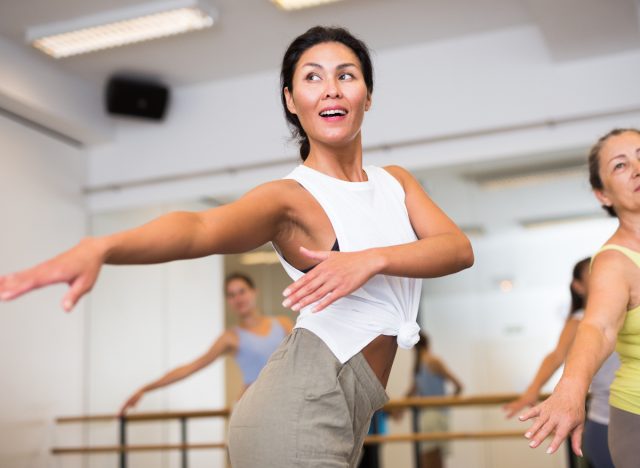

When dancing, you likely don’t feel like you’re “working out” at all—that’s the beauty of it. It’s an excellent place to start for those who are new to exercise.
“Simply moving and being active, especially if you’re dancing with your arms and legs, is an effective way to shuttle sugar out of the blood and into the dancing muscles of the arms and legs,” The Nutrition Twins tell us.
Bench Press or Chest Press


If you don’t have access to a chest press machine, you can perform pushups, wall pushups, or knee pushups.
“Just like the legs are a large muscle group, the chest is a large muscle group, and when you do a chest press, you [use] muscles in your chest, shoulders, and triceps,” explain The Nutrition Twins. “So it activates and strengthens a range of muscle groups, helping to burn through glucose, and helping to increase insulin sensitivity.”
Frequently Asked Questions (FAQs) About the 10 Best Exercises for Diabetes
Why is exercise important for managing diabetes?
Exercise is important for managing diabetes because it helps control blood sugar levels by increasing insulin sensitivity, promoting weight loss, and improving overall cardiovascular health.
What are the best types of exercises for diabetes?
1. Aerobic exercises: such as walking, jogging, cycling, and swimming, help improve insulin sensitivity and lower blood sugar levels.
2. Strength training: like weightlifting or bodyweight exercises, can increase muscle mass and improve blood sugar control.
3. Yoga: can help reduce stress, improve flexibility, and promote overall well-being for individuals with diabetes.
How often should I exercise to manage diabetes?
It is recommended to aim for at least 150 minutes of moderate-intensity aerobic exercise per week, spread out over at least 3 days. Additionally, including 2-3 days of strength training per week can provide added benefits for managing diabetes.
Can I exercise if I have complications from diabetes?
It’s essential to consult with your healthcare provider before starting any exercise regimen, especially if you have complications from diabetes. They can help tailor an exercise plan to suit your individual needs and ensure your safety while exercising.
Are there any exercises I should avoid if I have diabetes?
Avoid high-impact activities that may put excessive stress on your joints, especially if you have diabetic neuropathy. Activities with a high risk of injury, such as heavy lifting without proper form, should also be avoided. Always prioritize exercises that are safe and enjoyable for you.






